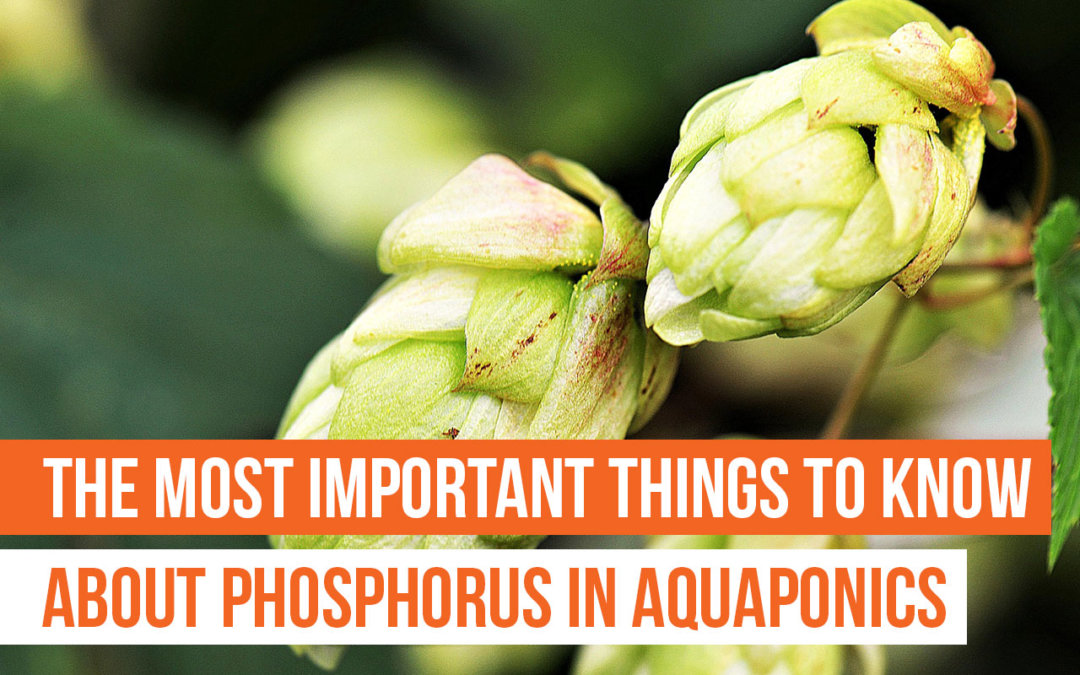Phosphorus in aquaponics
Phosphorus is one of the primary plant nutrients: the “P” in NPK ratings.
It is often overlooked in aquaponic systems simply because it is seldom truly deficient. However, many aquaponic practitioners are not getting the best possible yields out of their flowering and fruiting crops because phosphorus (while not necessarily deficient) is not present in high enough amounts during critical stages in production.
Phosphorus and algae blooms
 The cause of many algae blooms (see: eutrophication) is phosphorus from industrial agriculture that has washed from cropland into rivers, streams, and eventually the ocean. Along the way, algae—often inhibited by lack of phosphorus—bloom, consume oxygen and turn waters that were once vibrant and ecologically diverse into green, dead sludge.
The cause of many algae blooms (see: eutrophication) is phosphorus from industrial agriculture that has washed from cropland into rivers, streams, and eventually the ocean. Along the way, algae—often inhibited by lack of phosphorus—bloom, consume oxygen and turn waters that were once vibrant and ecologically diverse into green, dead sludge.
As a result, a lot of scrutinies have been directed at phosphorus. Whether it was soap, sewage, or runoff, anything with excessive amounts of phosphorus was closely regulated.
“Peak oil”? How about “peak phosphate”?
While there is a lot of phosphorus in circulation in nature, natural sources for agriculture are limited. In fact, while the world considers “peak oil” at length, most people are unaware that phosphorus in the form of rock phosphate (the primary source of phosphorus for industrial agriculture) is rapidly being consumed. We are at “peak phosphate,” a truly concerning point, as there are possible replacements for oil, but there are no great replacements for rock phosphate.
Phosphorus and plant growth
 Because phosphorus is very soluble and rapidly consumed by algae, it is often present in systems as soluble phosphate PO4-3 ions as well as organic forms. While these background levels are adequate for typical growth and development, when plants are flowering and trying to set fruit, more phosphorus is needed.
Because phosphorus is very soluble and rapidly consumed by algae, it is often present in systems as soluble phosphate PO4-3 ions as well as organic forms. While these background levels are adequate for typical growth and development, when plants are flowering and trying to set fruit, more phosphorus is needed.
A lack of phosphorus is one reason why many aquaponic tomatoes and peppers bear only small to moderate amounts, even when supplied with plenty of nitrogen-rich water.
In essence, nitrogen is the most important element (quantity-wise) for vegetative growth (leaves, stems, and roots) while phosphorus and potassium become more important for setting flowers, seeds, and fruits.
Phosphorus in aquaponic systems
So, for the aquaponic practitioner wishing to grow rich tomatoes, cucumbers, and peppers (all big fans of phosphate), how should phosphorus be supplemented? There are many possibilities, most of which are too risky or are too labor- or money-intensive.
The best way to supplement phosphate without spending much money is to use good old natural rock phosphate.
Rock phosphate
 Rock phosphate comes in a granular or dust form and can be sprinkled along the top of the grow-beds containing your fruiting crops once they start to flower. It will remain for some time, slowly releasing phosphate into the solution.
Rock phosphate comes in a granular or dust form and can be sprinkled along the top of the grow-beds containing your fruiting crops once they start to flower. It will remain for some time, slowly releasing phosphate into the solution.
When done correctly, much of the phosphate will be immediately consumed by the plants in the bed, reducing the amount that bleeds out into your system. Even if background levels of phosphate rise, this isn’t typically a problem in systems where all of the crops are fruiting crops.
If, however, you have vegetative crops (think basil, lettuce, kale, etc.), then excess phosphate (in part) can stimulate some of these crops to flower, which is not desirable.
It’s recommended that fruiting and vegetative crops are kept separate and grow in different systems. This is usually better anyway as fruiting crops are well adapted and appropriate for bed production, whereas vegetative crops are best grown in towers.
Phosphate additions and fish tanks
One thing to keep in mind, if you do choose to supplement phosphorus, is that your fish and sump tanks must be shaded, as additional phosphorus can cause algae bloom in unshaded systems—especially at higher levels.
If you’re able to successfully manage phosphorus in an otherwise healthy aquaponic system, you will be able to bump up your fruit and flower production significantly. If you have questions about what crops need phosphorus at different times in their development, check out one of the many great books on hydroponic nutrient solutions, or feel free to ask!
Phosphate levels in aquaponic systems
Most aquaponic systems shoot for phosphate concentrations between 10 and 20 ppm for light feeders (vegetative crops) and between 20 and 40 ppm for heavy feeders (tomatoes, cucumbers, etc.).
![]()
Quick tip: If you plan on running higher levels of phosphate in your system, prepare to supplement other nutrients at higher levels to balance your solution. But more on that later.
Nervous about making mistakes? Prevent mistakes from happening by reading about the ten most common aquaponics mistakes in this free eBook. Don’t wait to make your aquaponics system successful!
Be sure to read the other aquaponic nutrient blogs!



Though I get a bit frustrated by the complexities of aquaponics, I am grateful for those of you whom have been so kind to share your knowledge.
what is the ideal phosphate level in the aquaponics
plants like Lettuce, basil celery, and also for the rice